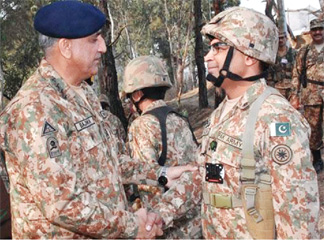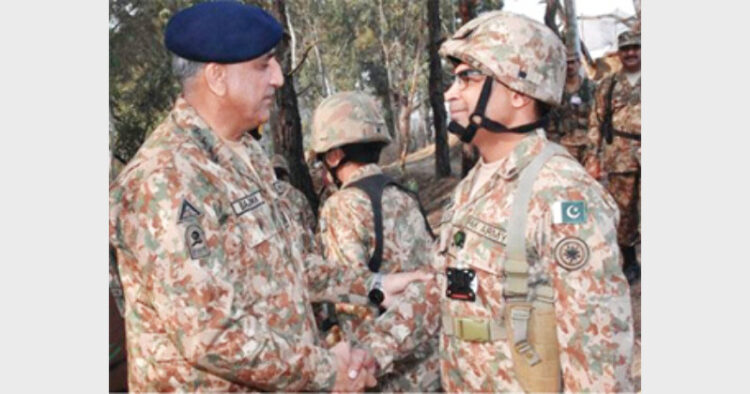 Pakistan Army has a long history of heinous and dastardly acts whether it was the ravage of Hur Jamat movement, the Baluch national movement, and Muhajir movement. The recent incident of mutilation of bodies of two Indian jawans reinforces it emphathically
Pakistan Army has a long history of heinous and dastardly acts whether it was the ravage of Hur Jamat movement, the Baluch national movement, and Muhajir movement. The recent incident of mutilation of bodies of two Indian jawans reinforces it emphathically
Santosh Verma
A Pakistan Army camp last week carried out a 45-minute artillery strike followed by an ambush on a patrol of the Indian Army in Krishna Ghati sector in Poonch district, leading to the death and injury of Indian soldiers. The onslaught did not stop there—Pakistan’s Border Action team (BAT) took advantage of the situation and crossed the Line of Control (LoC), killing and mutilating the bodies of two Indian soldiers—Naib Subedar Paramjit Singh (22 Sikh Regiment) and Head Constable Prem Sagar (200 BSF Battalion).
Timeline of Brutalities1999 Kargil war: Apart from the heavy casualties India suffered, one of the worst incidents during the Kargil war was the killing of Captain Sourabh Kalia and his troop. Captain Kalia was held as a war prisoner (PoW) by Pakistan. He along with five other soldiers, who were part of a patrolling team, were tortured brutally and his badly mutilated body was handed over to India. |
The BAT or Border Action team is specifically used by Pakistan for cross-border operations. In Pakistan, the SSG (special services group) forms the core of BAT. Its primary task is to dominate the LoC by carrying out disruptive actions in the form of surreptitious raids.
Cover Story/Opinion: Multi-pronged offensive called for
Opinion: Misplaced counselling
J&K/Opinion : Valley wails
It has to be noted that this is not the first time that Pakistan has carried out such demented acts.
These are just a few incidents which have been officially recorded. Over the years of conflict, several army men have been captured and have suffered a tragic fate.
Pakistan has a long history of such heinous and dastardly acts conducted by it’s security forces since 1947. Whether it was the ravage of Hur Jamat movement or Baluch national movement or movement for seeking some legitimate rights by Muhajirs. In the course of the oppression of Bengalis it was Operation Searchlight as an apparatus, itself designed as a genocidal military assault that would use terror as a weapon to crush the civilian movement. Soldiers were instructed by their officers to conduct calculated brutality against civilians so that they could never raise their voice against Pakistani occupation. While secretly preparing the army for the assault, General Yahya Khan, the then President of Pakistan, addressed his soldiers at a conference in February 1971 and said, “Kill three million of them (Bangladeshis) and the rest will eat out of our hands.” During the operation, General Tikka Khan, the then chief of Pakistan Army’s eastern command, ordered his soldiers, “I want the land and not the people.”
General Tikka Khan, was given the name the “butcher of Bengal” by the Bengalis for his actions. Khan, when reminded on 27 March 1971 that he was in charge of a majority province, said, “I will reduce this majority to a minority”
As a result, several hundred thousand Bengalee civilians were killed within the first few days of Operation Searchlight. Even General AAK Niazi, the successor of Tikka, wrote in his memoirs titled The Betrayal of East Pakistan, “The military action was a display of stark cruelty, more merciless than the massacre at Bukhara and Baghdad by Changez Khan and Halaku Khan and at Jalianwala Bagh by British General Dyer.”
During the 1971 Bangladesh war for independence,
members of the Pakistani military and supporting Islamist militias from Jamaat-e-Islami raped between two to four hundred thousand Bangladeshi women in a systematic campaign of genocidal rape. During the war, a fatwa in Pakistan declared that the Bengali ‘freedom fighters’ were Hindus and that their women could be taken as the ‘booty of war’. Imams and Muslim religious leaders publicly declared that the Bengali women were ‘gonimoter maal’ (war booty) and thus they openly supported the rape of Bengali women by the Pakistan Army.
In 2009, almost 40 years after the events of 1971, a report published by the War Crimes Fact Finding Committee of Bangladesh accused 1,597 people of war crimes, including rape. Since 2010 the International Crimes Tribunal (ICT) has indicted, tried and sentenced several people to life imprisonment or death for their actions during the conflict. This is well known fact that what Pakistan’s Army and it’s newly established 12th Core did in Baluchistan. Not only enemies face the brutal acts of Pakistan but its civilian also became the target of this madness since inception of Pakistan as a nation.
According to renowned Pakistani scholar Aqil Shah “At present, Pakistan’s domestic economic, developmental, and political problems are undoubtedly many and enormous. An economy trapped in a cycle of debt and deficits, a rapidly growing population, a low literacy rate, chronic energy shortages, and pernicious levels of poverty—to name a few of its economic-developmental woes—are interwoven with and complicated by the fragility of the state. But running through both the domestic and foreign dimensions of Pakistan’s past, present, and future is one connecting factor: an out-of-(civilian)-control army.
While the military expects the civilian leadership to provide policy guidelines, the military’s top brass is not giving the latter a free hand. There are certain policy areas where they accept no civilian interference; in the case of other issues, the top brass favours shared decision-making, albeit with the military having the stronger role. We saw this in suspension of Tareq Fatemi in which case ISPR head Major General Asif Gafoor make strong anti-
government comments. So these type of incidents which put the volatile relations in much more in perils, also provide Pakistan’s Army a leverage and “upper hand” on civilian government.
There are several reasons why such indignities are perpetrated by Pakistan. One is the plausible deniability that can be exercised by taking refuge behind the ‘non-state actors’ excuse.
Another is a basic psyche of a Pakistani soldier, which differs from that of his Indian counterpart. The late 1970s and the beginning of the 1980s saw the aggressive promotion of Islam in Pakistan Army, which was a sign of times to come. The increasing Islamisation of both the state
institutions and the general society, coupled with the Afghan war, was a turning point in the role of Islamic orthodoxy in Pakistan. Together they created the very infrastructure of the many militant groups and networks as well as the mindset that we see today. With his national identity strongly mingled with his religion, the soldier views the Indian counterpart not only as an enemy, but as an ‘other’ or more as an infidel.
Lawrence H Keeley, a professor of archaeology at the University of Illinois at Chicago, writes in his book War before Civilisation: the Myth of the Peaceful Savage (Oxford University Press, 1996), that mutilation of dead bodies has been a form of showing contempt for the social group of the enemy since time immemorial. It is most likely that acts of mutilation are carried out by a religious fundamentalist mind-set who thought that this is a religious duty to hate Indians and this type of inhuman treatment would be a sacrosanct practice.
A soldier’s martyrdom always evokes a deep sense of loss amongst his fellows and the nation, at large. Yet there was a traditional honour code about providing an appropriate dignity to the dead bodies of enemy soldiers once the fighting was done but dehumanising the adversary has been a backwash of war even in modern times.
Brutality in cold blood and mutilation of enemy dead bodies is prohibited and this is canonised in the fourth Geneva Convention of 1949, Article 16 of which states that “The wounded and sick, as well as the infirm, and expectant mothers, shall be the object of particular protection and respect. As far as military considerations allow, each Party to the conflict shall facilitate the steps taken to search for the killed and wounded, to assist the shipwrecked and other persons exposed to grave danger, and to protect them against pillage and ill-treatment.”
In the current perspective when government said it has “sufficient evidence” to prove that the two soldiers were mutilated by armed forces of Pakistan, the whole nation is
questioning what kind of strategy is required to daunt such savagery and what is the hurdle which prevent the government to take some unpalatable action against dastardly acts of Pakistan.
(The writer specialises in Pakistan Affairs )














Comments